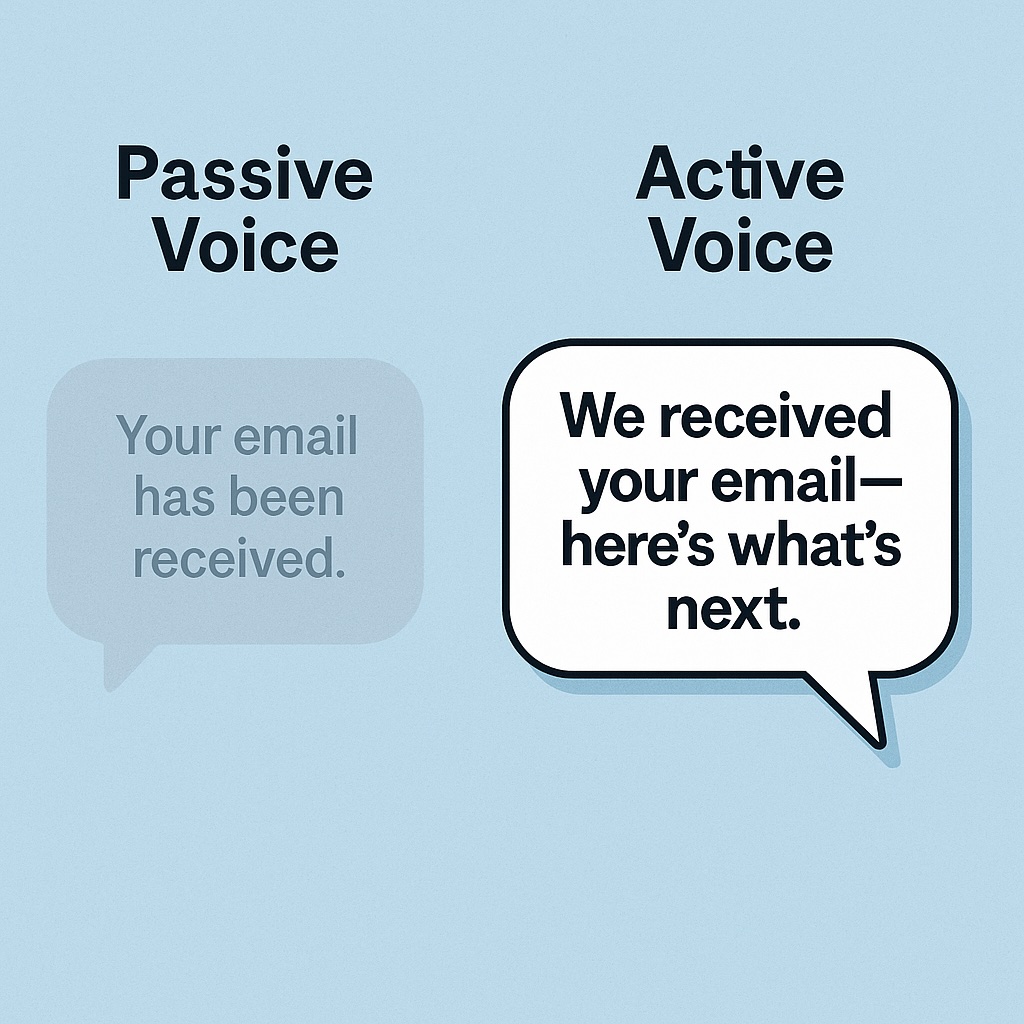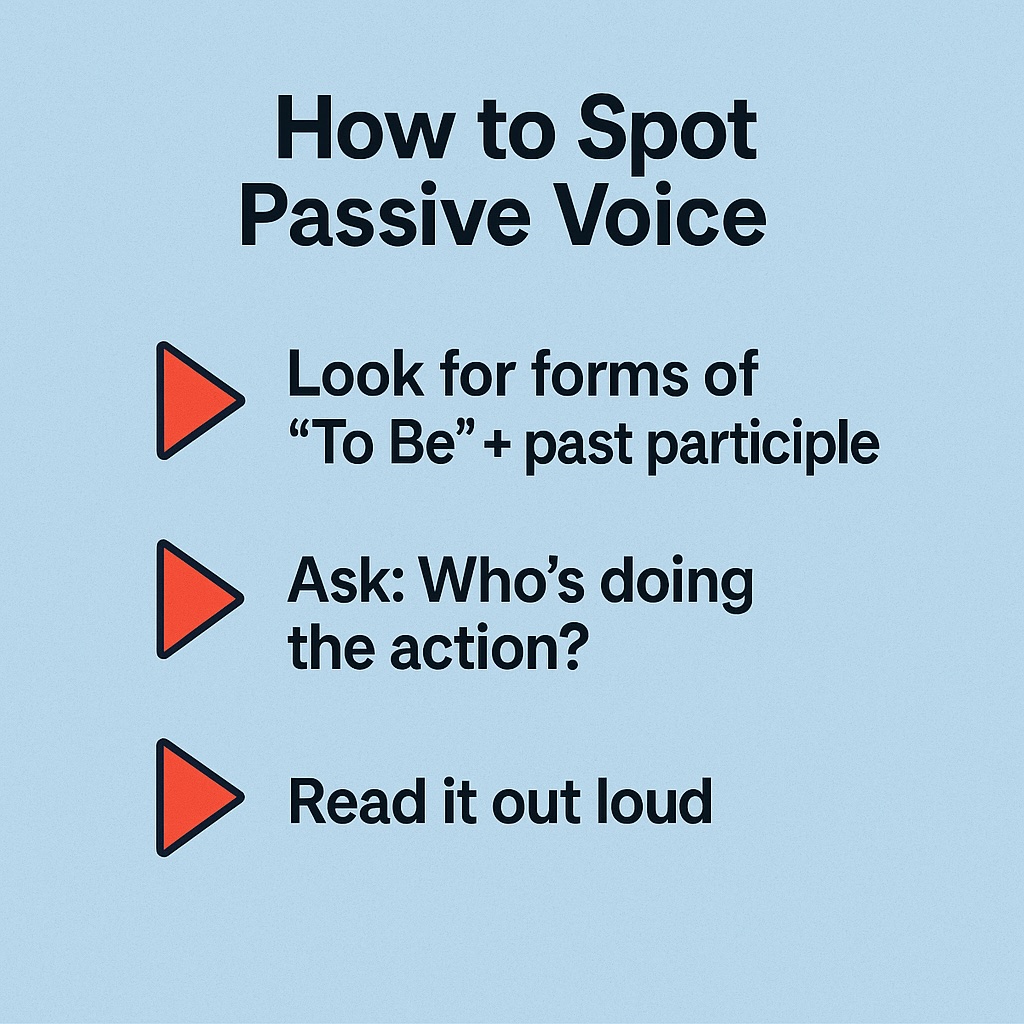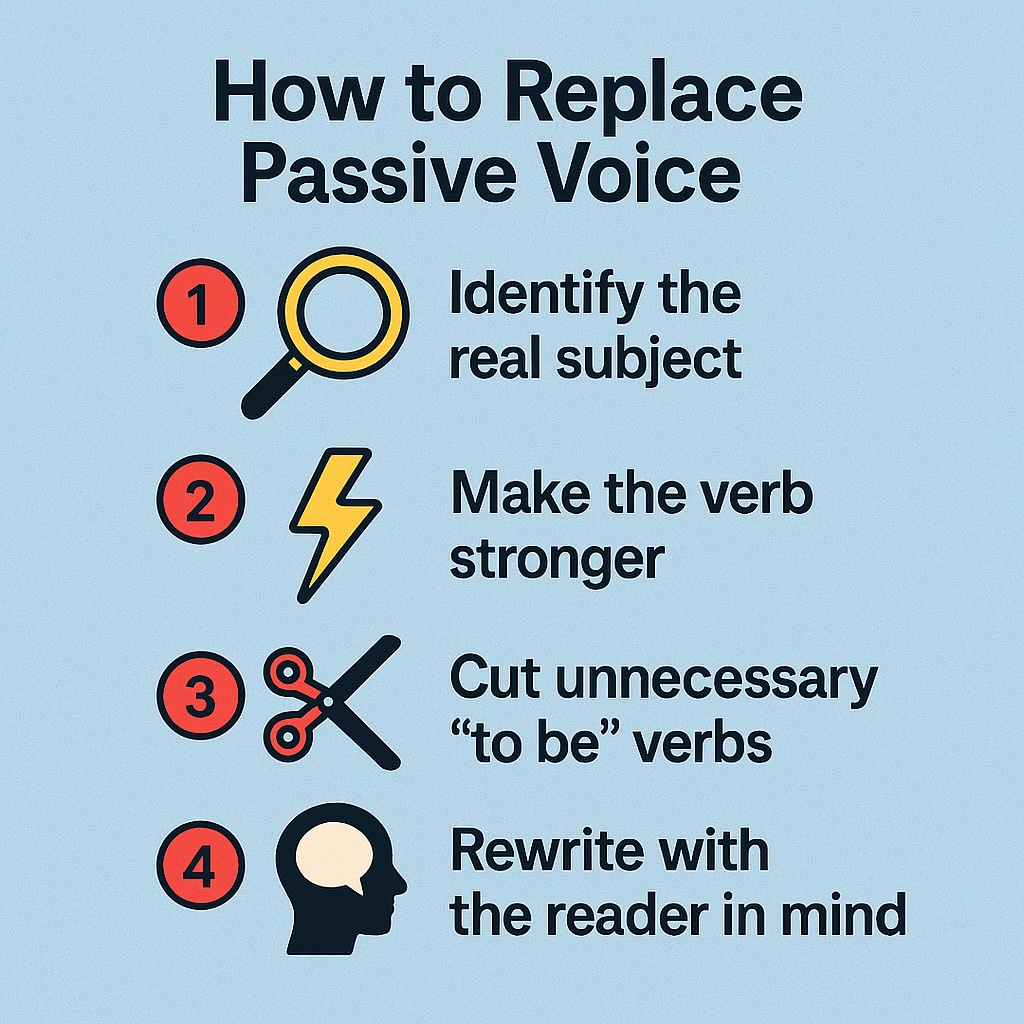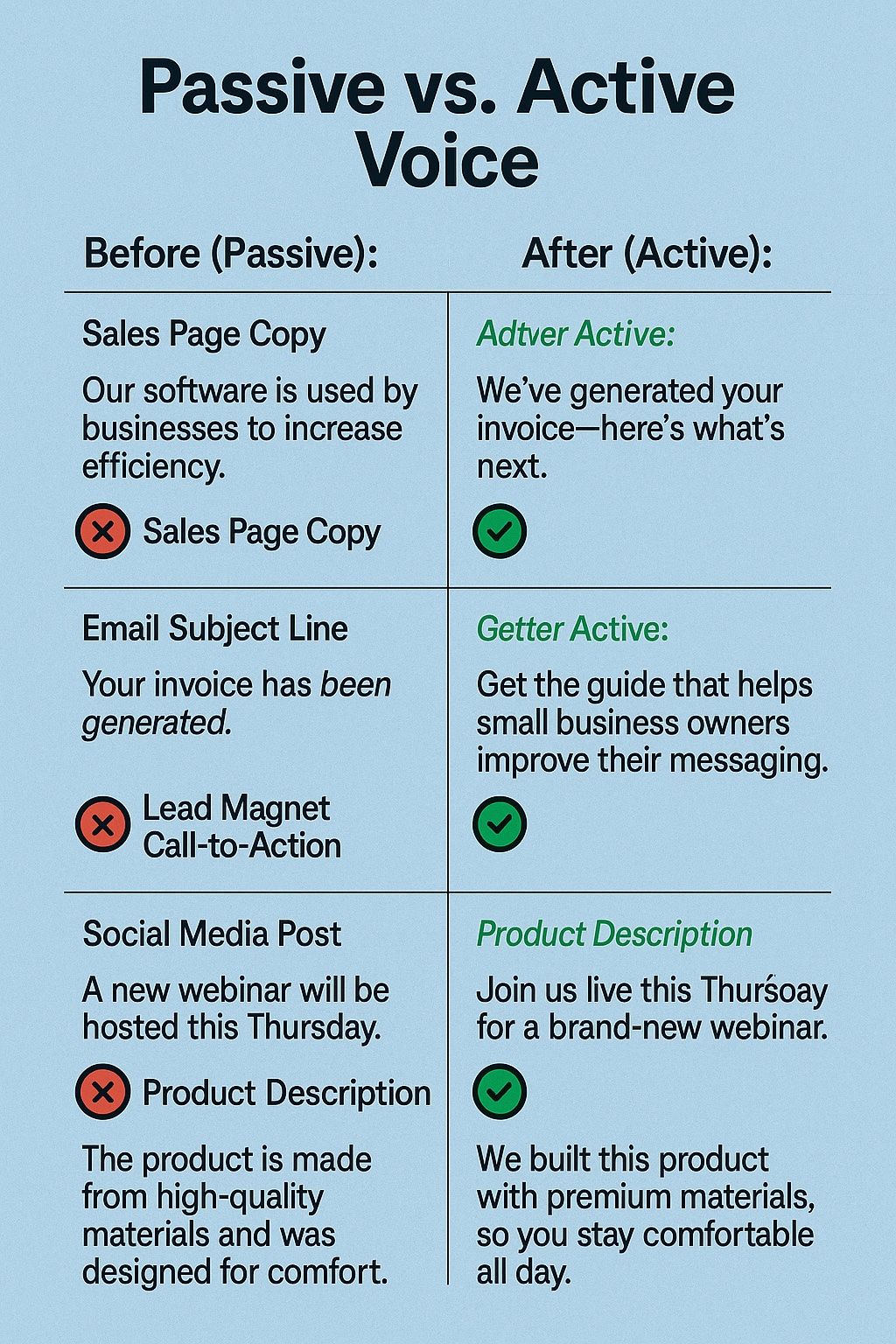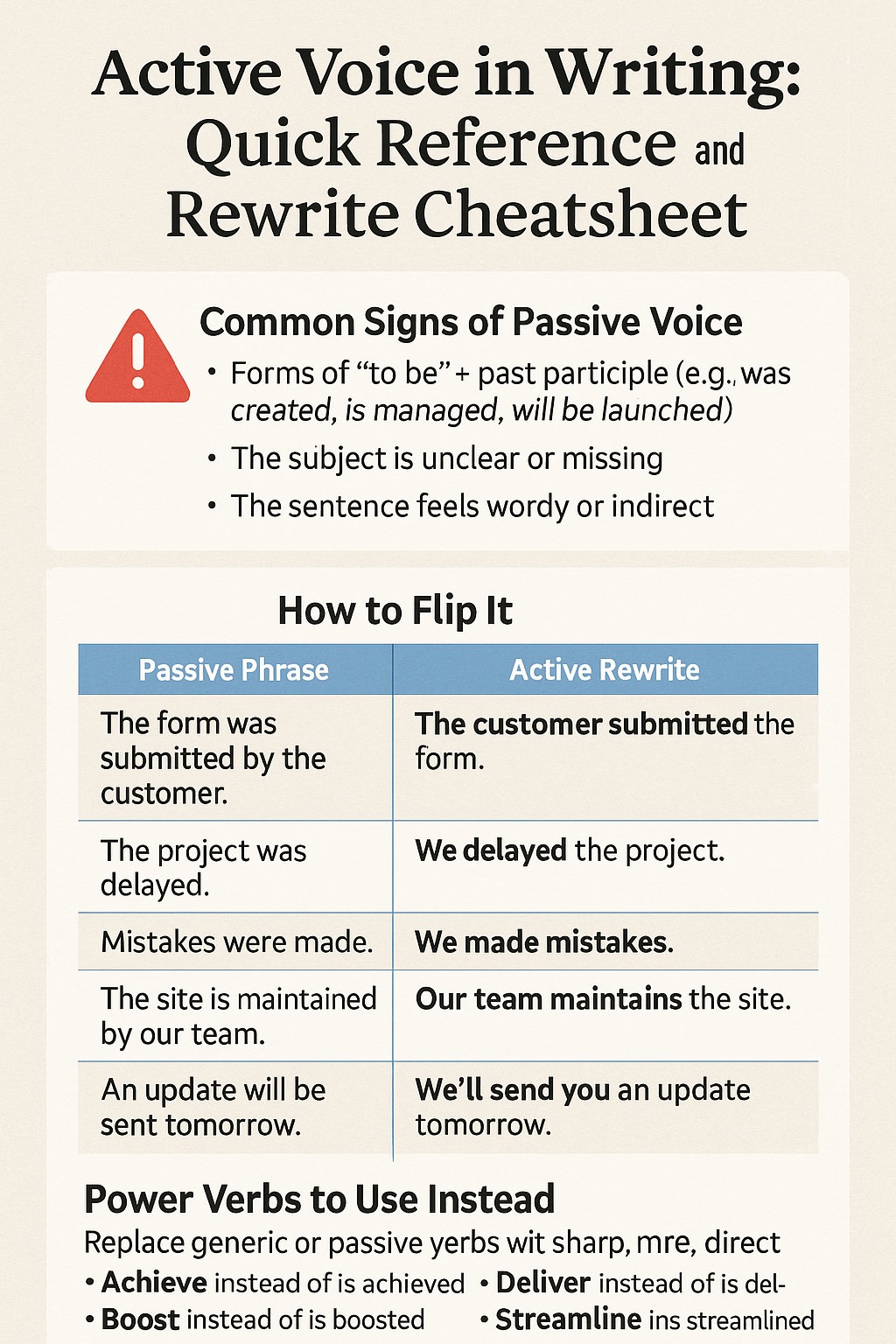I didn’t need more traffic—I needed stronger copy. Dropping passive voice helped me grab attention and convert more leads.
What’s Missing in Your Writing? It’s Not More Words—It’s the Right Ones.
Ever read something back and thought, Why does this feel flat? You had the idea. You made the point. But somehow, it still lacks punch.
Here’s the culprit nine times out of ten: passive voice. It’s sneaky. It shows up in “Mistakes were made” instead of “I made mistakes.” And just like that, your writing sounds vague, distant—like you’re sidestepping the spotlight.
Now flip the script.
With an active voice, your message becomes clear, direct, and impossible to ignore. You stop circling your point and start owning it. You say, “I launched the campaign,” not “The campaign was launched.” You create connection, confidence, and action.
In this guide, I’ll show you how to spot passive traps, rewrite them with impact, and turn your writing into a tool for clarity, trust, and persuasion.
It’s not about fluff. It’s about force. Let’s make your words work harder.
Why Passive Voice Fails—and How Active Voice in Writing Converts Better
💡 Quick Definition:
In passive voice, the action happens to the subject.
Passive: “The form was filled out by the customer.”
Active: “The customer filled out the form.”
The passive version buries the action and the reader’s interest.
🚫 Why Passive Voice Falls Flat in Copywriting:
It Lacks Energy
Passive sentences drag. They sound like they were written by committee… and probably were.
It Hides the Heroisual
Good copy makes the subject (often your reader or customer) the hero. Passive voice hides them in the background.
It Weakens Calls to Action
Compare:
“Your message will be improved by using active voice.”
vs.
“Use active voice to sharpen your message.”
The second? Clear. Direct. Actionable.
Would you like to move next into:
How to Spot Passive Voice—and Start Using Active Voice in Writing
Watch out for verbs like:
is, are, was, were, be, being, been
Followed by a past participle (usually a verb ending in -ed, like written, created, delivered).
Example:
❌ “The proposal was approved by the manager.”
✅ “The manager approved the proposal.”
If it’s not clear who’s doing the thing, you’ve probably gone passive.
Example:
❌ “The content was reviewed.”
✅ “The marketing team reviewed the content.”
If the subject is missing or an afterthought (tacked on with “by…”), it’s a red flag.
Passive sentences often sound awkward or overly formal when spoken.
Reading your draft aloud will instantly expose the lifeless phrases.
🛠 Use a Tool
If you’re still unsure, tools like Hemingway Editor or Grammarly can instantly highlight passive constructions.
I use them all the time.
How to Replace Passive Voice with Active Voice in Writing—Quick Fixes
🔁 1. Identify the Real Subject
Ask: Who’s taking action here?
If your sentence focuses on what’s being done to something, flip it and put the “doer”
first.
Before:
❌ “The strategy was developed by our team.”
After:
✅ “Our team developed the strategy.”
⚡ 2. Make the Verb Stronger
Passive writing often hides behind weak or generic verbs. Replace them with clear,
active ones that spark momentum.
Before:
❌ “This tool is used to streamline workflows.”
After:
✅ “This tool streamlines your workflow.”
✂️ 3. Cut Unnecessary “To Be” Verbs
Sometimes all it takes is trimming the fluff.
Before:
❌ “Your message will be improved by using active voice.”
After:
✅ “Active voice sharpens your message.”
📣 4. Rewrite with the Reader in Mind
Make your reader the subject when possible. This creates a more engaging,
action-driven tone.
Before:
❌ “The service is recommended for anyone struggling with time management.”
After:
✅ “Struggling with time? This service helps you take control.”
Pro Tip:
Don’t obsess over cutting every single passive sentence. Sometimes passive voice is appropriate (e.g., scientific or technical writing). But in copywriting, your default should be active—it’s what keeps readers moving forward.
Passive vs Active Voice in Writing: Before-and-After Copy Examples
📄 Sales Page Copy
Before (Passive):
❌ “Our software is used by businesses to increase efficiency.”
After (Active):
✅ “Businesses use our software to work smarter and get more done.”
✉️ Email Subject Line
Before (Passive):
❌ “Your invoice has been generated.”
After (Active):
✅ “We’ve generated your invoice—here’s what’s next.”
🧠 Lead Magnet Call-to-Action
Before (Passive):
❌ “This guide was created to help small business owners improve their messaging.”
After (Active):
✅ “Get the guide that helps small business owners improve their messaging fast.”
💬 Social Media Post
Before (Passive):
❌ “A new webinar will be hosted this Thursday.”
After (Active):
✅ “Join us live this Thursday for a brand-new webinar.”
🛍️ Product Description
Before (Passive):
❌ “The product is made from high-quality materials and was designed for comfort.”
After (Active):
✅ “We built this product with premium materials, so you stay comfortable all day.”
These rewrites aren’t just cleaner—they’re more confident, more persuasive, and more human. That’s the power of active voice.
Active Voice in Writing: Quick Reference and Rewrite Cheatsheet
Here’s a cheat sheet you can keep nearby anytime you’re editing copy, writing content, or crafting email.
🚨 Common Signs of Passive Voice
🔄 How to Flip It
Passive Phrase
“The form was submitted by the customer.”
“The project was delayed.”
“Mistakes were made.”
“The site is maintained by our team.”
“An update will be sent tomorrow.”
Active Rewrite
“The customer submitted the form.”
“We delayed the project.”
“We made mistakes.”
“Our team maintains the site.”
“We’ll send you an update tomorrow.”
💥 Power Verbs to Use Instead
Replace generic or passive verbs with sharper, more direct action words:
Keep this table near your draft while editing—it’s a quick way to catch weak copy before it goes live.
Conclusion: Write Like You Mean It—Starting Today
Passive voice isn’t just dull—it’s a drag on your credibility. Every vague sentence chips away at your message. Every passive phrase makes your writing easier to ignore.
But now you know better. And better writers take action.
Don’t just nod along—do something with this.
In the next 10 minutes, open your latest draft and find five passive sentences. Rewrite them. Make the subject take action. Feel how your message sharpens.

